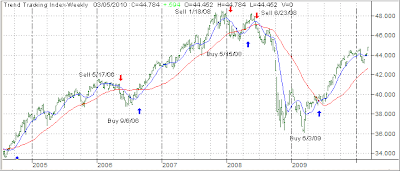Since I’ll be traveling most of this weekend, I won’t be able to post this Sunday. Regular posting will resume on Monday when I return to the office.
Wealth Destroyers
 MarketWatch had this to say in “Wealth creators vs. wealth destroyers:”
MarketWatch had this to say in “Wealth creators vs. wealth destroyers:”
To learn that your mutual-fund firm’s lineup posted negative returns over a decade is one thing; to realize that almost $60 billion of investors’ wealth was wiped out is another matter entirely.
That’s what happened at Janus Capital Group Inc. from 2000 through 2009. The fund giant’s offerings collectively saw 10-year asset weighted total return of minus 1% a year, which translates into $58.4 billion of investment losses.
Janus was the worst “wealth destroyer” in a study released this week from investment researcher Morningstar Inc. Results were not much better at Putnam Investments, which shredded $46.4 billion of shareholder wealth in the period, while mutual funds at AllianceBernstein Holdings and Invesco Aim, a unit of Invesco Ltd. lost shareholders $11.4 billion and $10.1 billion, respectively.
The figures show that fund investors risk not only picking the wrong type of investment, but also choosing the wrong firm for the job. All five of these fund families were heavily invested in technology and growth stocks — the decade’s biggest wealth-destroying fund categories. Large-cap growth funds lost $107.6 billion for investors while tech funds erased $62.8 billion of their money in the period.
“Results were really influenced by what happened at the start of the decade, when investors rushed to tech and growth and then they crashed,” said Sonya Morris, editorial director at Morningstar.
I continue to be amazed that, even with the benefit of hindsight, the blame is being put on mutual fund companies and not where it really belongs. While I am not a friend of some of the companies mentioned in this article, fund firms are simply following the rules their charter, which dictates that they are to be invested in their area of expertise (large growth, mid-cap, etc.) at all times, so that the public has the opportunity to buy and sell their funds.
In other words, all offered equity funds will always be long in the market, no matter what. While this works well during bullish periods, it will turn into disaster whenever a bear market strikes, especially if it happens twice in a decade. Sure, depending on their stated objectives, some equity funds lost less than others, but they still lost.
Given this known set up, mutual funds are not the wealth destroyer as they were made out to be in this story. The real culprit and destroyer of wealth was the investment approach, if you can call it that, of mindless buying and holding.
All of the above mentioned funds did well in the past decade during times of bullishness. It’s a matter of fact, I owned many of them but only as long as they were trending upwards.
The bottom line is that it’s not always the investment that should be blamed for poor performance; it’s what you do with it that matters.
The lesson learned from the past decade should be that the blame lies with the investment approach and not necessarily with the investment as I pointed out in “Saving A “Good” Mutual Fund From A Bad Ride.”
No Load Fund/ETF Tracker updated through 3/4/2010
My latest No Load Fund/ETF Tracker has been posted at:
http://www.successful-investment.com/newsletter-archive.php
A better than expected unemployment report pushed the major indexes higher with the S&P; 500 gaining 3% for the week.
Our Trend Tracking Index (TTI) for domestic funds/ETFs has now crossed its trend line (red) to the upside by +4.91% keeping the current buy signal intact. The effective date was June 3, 2009.

The international index has now broken above its long-term trend line by +5.67%. A Buy signal was triggered effective May 11, 2009. We are holding our positions subject to a trailing stop loss. 
[Click on charts to enlarge]
For more details, and the latest market commentary, as well as the updated No load Fund/ETF StatSheet, please see the above link.
Running Out Of Steam
In an almost identical performance from the prior trading day, the early rally attempt on Wednesday was rebuffed, and the major indexes ended up essentially unchanged.
For the time being, it seems that selling sets in when the S&P; 500 moves to its resistance level in the 1,125 area. Even decent economic news could not prevent the slide.
Maybe it’s the calm before the storm on Friday when the Labor Department issues its nonfarm payroll report. Economists predict a loss of 75,000 jobs in February in part due to the winter storms.
If this number comes in much better, we might see another attempt to break through the S&P;’s resistance level. If it comes in much worse, we could see more acceleration to the downside. Again, there is no reason to make quick, irrational decisions; let the market come to you and execute your sell stops if/when necessary.
Will Gold Be The Next Bubble?
 If you believe the heavy hitters of the investment world, gold could be the next bubble as “Soros Signals Gold Bubble:”
If you believe the heavy hitters of the investment world, gold could be the next bubble as “Soros Signals Gold Bubble:”
George Soros is helping drive up gold prices by doubling his bet in a market even he considers a “bubble” as Goldman Sachs Group Inc., Barclays Capital and HSBC Holdings Plc predict more gains before it bursts.
Soros Fund Management LLC, which manages about $25 billion, increased its investment in SPDR Gold Trust, the world’s largest exchange-traded fund for the metal, by 152 percent in the fourth quarter, a Feb. 16 Securities and Exchange Commission filing shows. While prices have fallen 9.2 percent since reaching a record on Dec. 3, 15 of 22 analysts in a Bloomberg survey say gold will reach a new high, with the median forecast predicting a 17 percent advance to as much as $1,300 an ounce this year.
“When interest rates are low we have conditions for asset bubbles to develop, and they are developing at the moment,” Soros said at the World Economic Forum’s annual meeting in Davos, Switzerland, in January. “The ultimate asset bubble is gold,” he said.
In a Jan. 28 Bloomberg Television interview, the 79-year- old billionaire recalled that former Federal Reserve Chairman Alan Greenspan warned of “irrational exuberance” in financial markets three years before the technology bubble burst in 2000. The Standard & Poor’s 500 Index rose 89 percent in the period. Buying at the start of a bubble is “rational,” Soros said.
What is rational to George Soros with his deep pockets may or may not be rational to you. While a bubble may indeed form in the future, the path to bubble level will not be a smooth one and very likely be interrupted by violent price swings in both directions.
So don’t be lured by his assumptions, which may very well come true but could bankrupt you if you plowed a large portion of your assets into gold. Treat gold like any other investment by using a trailing sell stop to limit downside risk.
Getting stopped out does not mean you can’t reenter again, just be aware that gold can be extremely volatile and caution is advised despite its long term potential.
Disclosure: We currently have limited positions in GLD.
10 Rules For Buying ETFs
 I came across this article titled “The 10 Rules You Need to Know Before Investing in ETFs.”
I came across this article titled “The 10 Rules You Need to Know Before Investing in ETFs.”
While most are well known, I was surprised to see rule # 8 “Have an Exit Strategy;”
What would cause you to change your mind and re-evaluate your position? Is the reason you purchased the ETF still valid? Have the fundamentals changed? Have the technicals changed? “Consider the use of a stop loss, even a mental one that causes you to re-evaluate your holding,” says Jergovic.
I applaud this writer for including one of the most elemental safety nets of investing in this article.
Here’s rule # 10, which I want to hone in on a little bit:
Separate Your Serious Money From Your “Ice Cream Money.” Know the type of money you are investing in ETFs. Never speculate with serious money you cannot afford to lose, says Jergovic. “When investors speculate with serious money and invest long-term with ice cream money, meeting objectives becomes problematic.”
This is a very important topic, which I have discussed many times, but not written about. There are some investors with the urge to do big things, like the equivalent of hitting a home run in the investment arena.
Actually, I have clients like that. They have divided their money into two pots; a small one, which is called their play money and a larger one, which I manage, which I refer to as their serious money.
With that small pot, they do the wildest things in the market you could ever imagine, hoping for a big hit, while at the same time satisfying their gambling instinct.
There is nothing wrong with that if you are so inclined. Their serious money is invested conservatively with clearly defined risk as per the trend tracking principles.
Some investors I know prefer doing their own thing and are managing both pots. Therein lies the danger in that the goals for each can become blurred and overlapping with the result that a clear separation can’t be maintained.
If do your own investing, and you are facing this situation, be absolutely clear as to which account you are dealing with so that you never become tempted to do crazy things with your serious money.

